Maria Santissima del Bagno
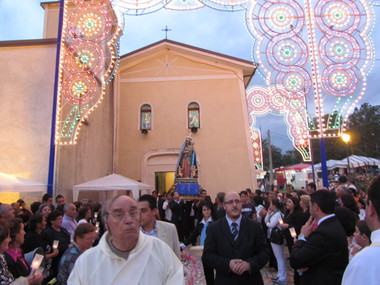
Last night’s festivities in honour of la Madonna del Bagno began with Holy Mass at 7:00 p.m. The Father Guardian of the Franciscan Solitude of San Pasquale was present together with the assistant Maestro dei Novizii and three fine novices. The little shrine church was absolutely full, with the overflow standing in the piazza outside. The procession with the statue of the Madonna del Bagno followed. A group of stalwarts carried the statue of the Madonna, crowned (together with the Bambino Gesù in her embrace), and clothed in a veil of blue silk with golden stars embroidered over it. A brass band began to play and a volley of fire works announced the arrival of the Madonna in the piazza.
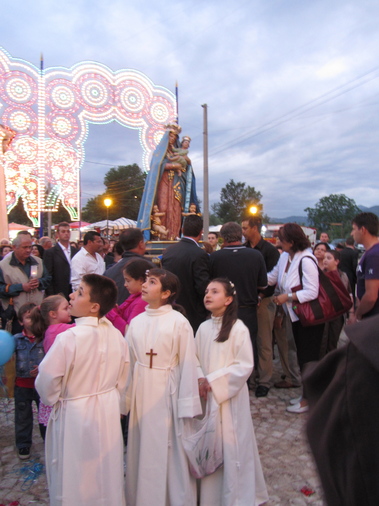
The devotion to the Madonna del Bagno in Gioia Sannitica grew up around a little church adjacent to a hermitage (there are many of these in Southern Italy) built in about the year 1700. There are documents revealing that the church and hermitage were constructed at the expense of the faithful in the place where, according to local tradition, shepherds found an image of the Madonna on canvas in a well. The well, still producing fresh water, is present near the church. The miraculous image is preserved in a frame of carved stone in the apse of the church.
The feast of this particular Madonna coincides with the festival of the Ascension. It is customary for the faithful to enter the church and make their way on their knees to the altar of the Madonna, where they wipe their faces with a towel that has been passed several times over the miraculous image.
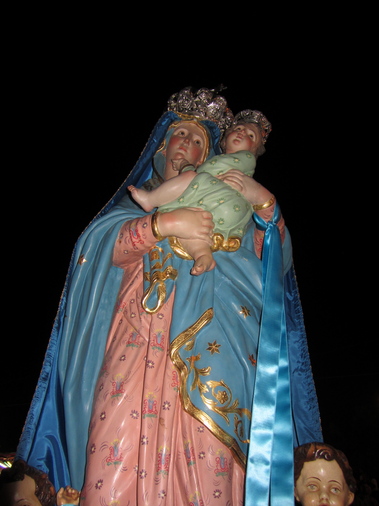
Again, according to the local tradition, the finding of the image of the Madonna was the occasion of numerous miracles. Many persons stricken by leprosy and other diseases were cured after having been washed in water from the well. The curious title, Madonna del Bagno, meaning “Our Lady of the Bath,” is related to these prodigies.
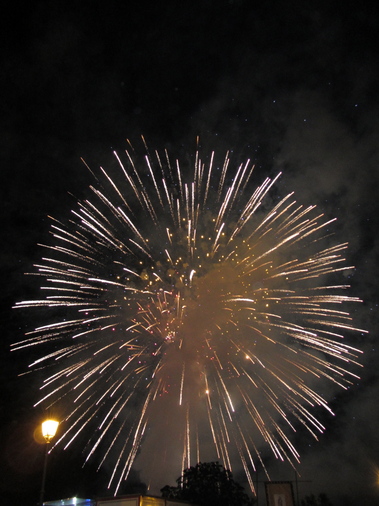
The church itself is a temple devoid of any particular artistic interest. It has a single nave; the ceiling is adorned with paintings of the Madonna. There are many ex-votos, including offerings of gold and jewelry, that bear witness to the graces received. A crowned statue representing the Madonna of the original image on canvas is enthroned above the altar.
Emmigrants from Gioia all over the world and, in particular, in and around New Haven, Connecticut, remain attached to the devotion to the Madonna del Bagno, and still send their offerings to contribute to the annual feast.
The sanctuary of the Madonna del Bagno remains a holy place where the Mother of God makes her presence known, touching hearts, bringing healing to souls and bodies, reconciling sinners to her Divine Son, and uniting families in the bonds of a common faith.
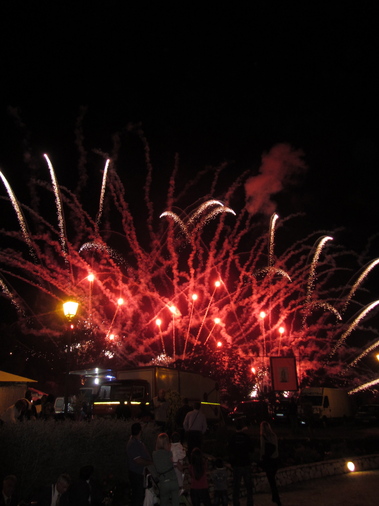
Last night, a number of offerings of gold and jewelry were pinned to a blue cushion at the Madonna’s feet. Women and children threw handfuls of rose petals at the statue as the Madonna passed. There were several resting places during the procession, each one marked by an altarino constructed and decorated by a family. At each of these stations, a priest led a decade of the Rosary and invocations to the Mother of God for particular intentions.
The procession wound its way all through the countryside, past vineyards, fields, olive groves, and grazing cattle. At various poInts along the way the faithful had prepared carpets of flower petals artistically arranged to form the monongram of the Ave Maria, a heart, a crown, or other Marian symbols. Only those bearing the sacred image of Madonna could walk over these floral carpets of devotion.
The phenomenal display of fireworks at the end of the procession was also a tribute of love and devotion to the Madonna. The statue was set on a base facing the fireworks display so that the Madonna could enjoy it, as Mother and Queen, in the midst of her children. At the end of the fireworks display, I was given the very great honour of offering the final incensation to the Madonna. The photograph of this is very dark. It was, of course, well after 11:00 p.m.
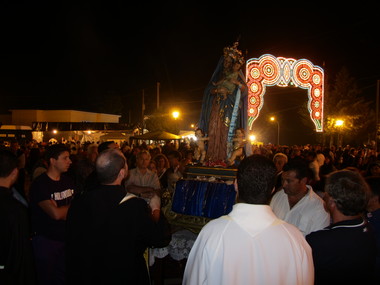
During the procession the brass band played the popular hymn attributed to Saint Alfonso Maria de Liguori, Evviva Maria. You can listen to it here.
Everyone, old and young, knew the words of the hymn by heart, and sang with tremendous devotion, vigor, and simplicity:
O Maria, quanto sei bella,
Tu sei la gioia, Tu sei l’amore;
Tu hai rapito questo cuore,
notte e giorno io penso a Te.
Tu hai rapito questo cuore,
notte e giorno,
notte e giorno penso a Te.
O Mary, how beautiful thou art,
thou art joy, thou art love;
thou hast ravished this heart;
night and day I think of thee.
Thou has ravished this heart,
night and day,
night and day I think of thee.
Evviva Maria,
Maria evviva.
Evviva Maria,
e Chi la creò.
Hurrah for Mary,
Mary, Hurrah!
Hurrah for Mary
and for He who created her.
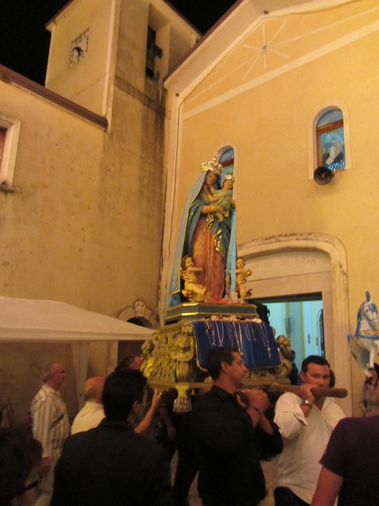
Quando il sole è già lucente
le colline e il mondo indora,
quando a sera si scolora
Ti saluta il mio pensier.
Quando a sera si scolora,
Ti saluta,
Ti saluta il mio pensier.
When the sun is already gleaming,
the hills and the world shine like gold,
when at eventide all grows dark
my thought greets thee,
my thought greets thee.
Evviva Maria,
Maria evviva.
Evviva Maria,
e Chi la creò.
Hurrah for Mary,
Mary, Hurrah!
Hurrah for Mary
and for He who created her.
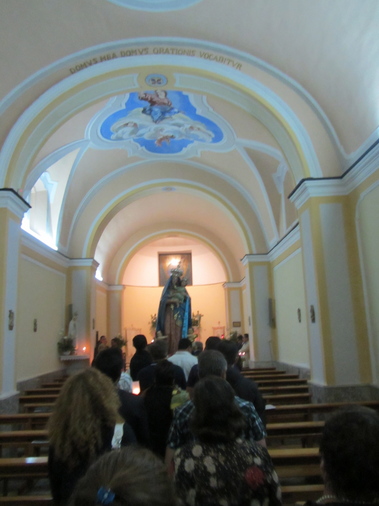
E un bel giorno in Paradiso
Grideremo: Viva Maria!
Grideremo: Viva Maria!
Viva Lei che ci salvò
Grideremo: Viva Maria!
Viva Lei,
viva Lei che ci salvò.
And one day in Paradise
We will cry: Hurrah for Mary!
We will cry: Hurrah for Mary!
and long live her who saved us.
Will will cry: Hurrah for Mary!
Long may she live who saved us.
Evviva Maria,
Maria evviva.
Evviva Maria,
e Chi la creò.
Hurrah for Mary,
Mary, Hurrah!
Hurrah for Mary
and for He who created her.

Grazie for this beautiful post! I hope to be there someday for this beautiful festival!